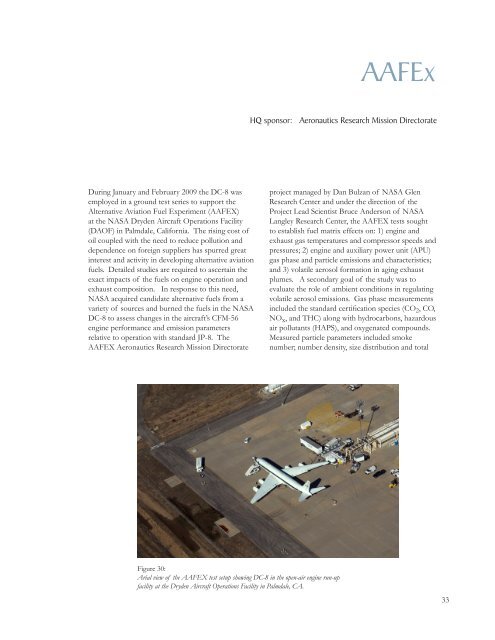2009 Annual Report - NASA Airborne Science Program
2009 Annual Report - NASA Airborne Science Program
2009 Annual Report - NASA Airborne Science Program
You also want an ePaper? Increase the reach of your titles
YUMPU automatically turns print PDFs into web optimized ePapers that Google loves.
AAFEx<br />
HQ sponsor: Aeronautics Research Mission Directorate<br />
During January and February <strong>2009</strong> the DC-8 was<br />
employed in a ground test series to support the<br />
Alternative Aviation Fuel Experiment (AAFEX)<br />
at the <strong>NASA</strong> Dryden Aircraft Operations Facility<br />
(DAOF) in Palmdale, California. The rising cost of<br />
oil coupled with the need to reduce pollution and<br />
dependence on foreign suppliers has spurred great<br />
interest and activity in developing alternative aviation<br />
fuels. Detailed studies are required to ascertain the<br />
exact impacts of the fuels on engine operation and<br />
exhaust composition. In response to this need,<br />
<strong>NASA</strong> acquired candidate alternative fuels from a<br />
variety of sources and burned the fuels in the <strong>NASA</strong><br />
DC-8 to assess changes in the aircraft’s CFM-56<br />
engine performance and emission parameters<br />
relative to operation with standard JP-8. The<br />
AAFEX Aeronautics Research Mission Directorate<br />
project managed by Dan Bulzan of <strong>NASA</strong> Glen<br />
Research Center and under the direction of the<br />
Project Lead Scientist Bruce Anderson of <strong>NASA</strong><br />
Langley Research Center, the AAFEX tests sought<br />
to establish fuel matrix effects on: 1) engine and<br />
exhaust gas temperatures and compressor speeds and<br />
pressures; 2) engine and auxiliary power unit (APU)<br />
gas phase and particle emissions and characteristics;<br />
and 3) volatile aerosol formation in aging exhaust<br />
plumes. A secondary goal of the study was to<br />
evaluate the role of ambient conditions in regulating<br />
volatile aerosol emissions. Gas phase measurements<br />
included the standard certification species (CO 2 , CO,<br />
NO x , and THC) along with hydrocarbons, hazardous<br />
air pollutants (HAPS), and oxygenated compounds.<br />
Measured particle parameters included smoke<br />
number; number density, size distribution and total<br />
Figure 30:<br />
Arial view of the AAFEX test setup showing DC-8 in the open-air engine run-up<br />
facility at the Dryden Aircraft Operations Facility in Palmdale, CA.<br />
33











